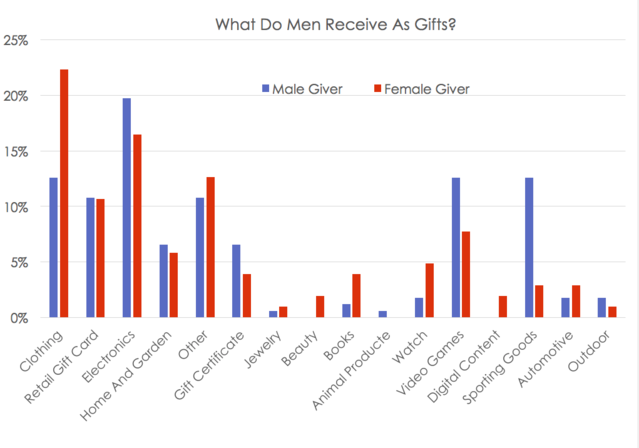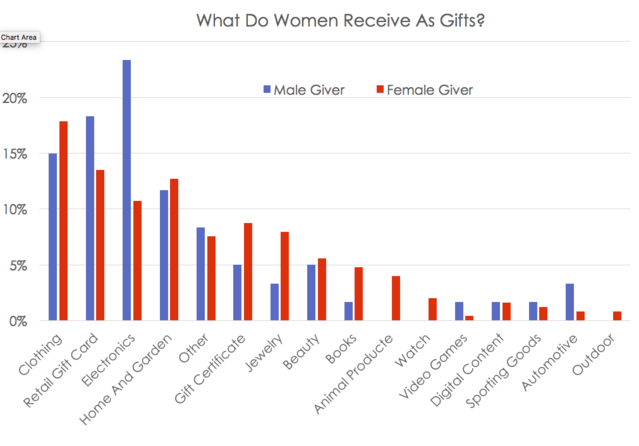
Gender
What Gifts Do Men and Women Buy for Each Other?
Learn what types of gifts men and women give each other.
Posted April 17, 2017
A few weeks ago, I wrote a post about which gender is harder to buy for. (Short answer: it’s hardest for men to buy gifts for women.) I discussed an experiment in which I asked about 200 people to think of three gifts for a specific other person. I then took a look at what the giver’s and receiver’s gender was to learn something about how the sexes buy gifts for each other.
For this post, I took all 600 or so gifts that people came up with and had them categorized into 16 categories (plus “other”). These were things like clothing, electronics, home and garden, etc. What I was most curious about was what types of gifts the sexes buy for each other (e.g., women buying for other women) versus for the opposite sex (e.g., women buying for men). Below are a few figures that summarize the data and pull out a few highlights.
First, overall, what do women and men buy as gifts?

There’s a lot here, but the way to read this is that the red bars represent the percentage of all gifts generated by women and the blue bars represent all gifts generated by men. For example, of all gifts given by women, about 19 percent were clothing items (e.g. shoes, sweater), as compared to only 13 percent of all gifts given by men. There are a lot of interesting things to observe here, but I’ll come back to the big ones after the next two graphs.
Next are two graphs in which we only look at gifts received by each gender from each gender. In the first graph, we are only looking at the gifts received by men.

The way to read this is that blue bars represent gifts given by men to men, while the red bars represent gifts given by women to men. For example, of all gifts that men gave to other men, about 13 percent were clothing items. This is in comparison to all gifts women gave to men, of which about 23 percent were clothing items.
Finally, this next graph is the same as the one above, except it represents all gifts received by women.

The way to read this is that blue bars represent gifts given by men to women, while the red bars represent gifts given by women to women. For example, of all gifts that men gave to women, about 24 percent were electronics items. This is in comparison to all gifts women gave to other women, of which only about 11 percent were electronics items.
Now let’s talk about the three most interesting findings:
1. Women are much more likely to give clothing items as gifts as compared to men (19 percent versus 13 percent of all gifts). On the surface, this isn’t all that surprising. What is surprising, however, is that women are MUCH more likely to give clothing to men as compared to men who are giving to men (23 percent versus 13 percent). That is, women give men clothing, but men don’t, to the same degree. This is all the more interesting when you consider that men are just as likely as women to give clothing to women (15 percent versus 17 percent of all gifts given to women).
2. Men are much more likely to give electronics as compared to women (21 percent versus 13 percent of all gifts given). Again, not that surprising on the surface, but what is surprising is that men love to give women electronics much more than women like to give electronics to each other (23 percent versus 11 percent of all gifts given to women). But when giving to men, both sexes are roughly equally likely to give electronics (19 percent versus 16 percent of all gifts given to men). In other words, men love to give women electronics.
3. Men are much more likely to give video games and sporting goods as compared to women (9 percent versus 3 percent of all gifts given for video games, and 9 percent versus 2 percent of all gifts given for sporting goods). This one pretty much follows gender stereotypes: Almost no one gives video games or sporting goods to women, and men are much more likely than women to give video games and sporting goods to each other (13 percent versus 7 percent of all gifts received by men for video games, and 13 percent versus 3 percent of all gifts received by men for sporting goods). Sometimes gender stereotypes do prove true.
These findings were really quite surprising and exciting. Of course, there’s a whole lot more to find, and I’ll ask you all for your ideas. What else do you see here? Leave your ideas in the comments.

